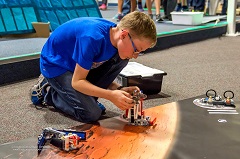February 20, 2019
2019 Kansas 4-H SpaceTech Changes for the Kansas State Fair

The 2019 Kansas 4-H SpaceTech rules have been further cleaned up due to technology changes and clarifications. Some of the major changes include:
- For all division, if a safety violation is noted by the judges, superintendent, or other staff, the exhibitor’s exhibit, at the judges’ discretion, will receive a participation ribbon.
- Computers. System-On-A-Chip (SOC) (such as a Raspberry Pi) or a Micro-Controller (such as an Arduino or Ozobot) AND is a compact (less than 4”X4”X4”) system, which can be programmed AND requires minimal assembly to operate (e.g. connecting power, display, and keyboard/mouse cables).
- Chip systems may use/include GPIO bread boards or HATs (Hardware Attached On Top) the size of which is not included in the size of the chip system, however the total size of the chip system and GPIO devices may not exceed 24”X24”X24” including any display cases. Class 5594 has been added - Chip system – a small (4”X4”X4”) programed physical device that accomplishes a specific task.
- Robotics. Robots must have automated reticulated structures (arms, wheels, grippers, etc.). Game consoles that display on a screen are not considered robots and should either be entered in computer systems division or energy management project. Robots requiring no assembly, just programming, such as Ozobots, are considered computer systems projects as the skill is focused on the programming not on the construction of the robot.
- In the event that the robot uses a device like a phone, iPad, or tablet for programming AND operation, DO NOT include the device (phone, tablet, etc.). The device’s safety cannot be insured. Instead record a video demonstrating the instructions included for your robot. It should show, setting up the robot, starting the robot, the robot executing its task, and powering off the robot, just like the instructions are written.
- Rocketry. For the purposes of Kansas 4-H SpaceTech a mid-powered rocket is defined as a rocket that uses an ‘E,’ ‘F,’ ‘G,’ or equivalent engine for launch. In addition, rockets also qualify for mid-power if they meet any of the following criteria:
a. Is 2 inches or greater in diameter (not including fins) and taller than 3 feet (36 inches including fins) and do not use an engine(s) exciding 160.01 Newton seconds of total impulse (an ‘H’ engine equivalent or above).
b. The total impulse of all engines used in the rocket is greater than 20.01 Newton-seconds and less than 160.01 Newton-seconds.
- Fin assemblies that are printed using a 3D printer are excluded from this prefabricated fin assembly rule. Though detailed instructions on the creation of the fin assemblies must be provided and an additional page of photos may be included to show the creation/printing of fin assemblies.
- Alternative Skins for ages 14 and up has been deleted.
- Mid-power Rocketry (2x‘D’ to ‘G’ Engines) Guidelines. Purpose: To allow for improved safety and judging of rockets that meet the requirements of 4-H mid-power rockets.
- Exhibitors in this division must hold memberships in either NAR or Tripoli organizations.
- High power rockets as defined above (‘H’ or ‘I’ engines) may not be launched in this division.
- If according to Federal Aviation Regulations Part 101, a waiver is required to fly the rocket, a copy of that waiver is to be attached to the High Power Information Form. In the case where the launch was a public event a substitute to a copy of the waiver is the Range Safety Officers (RSO’s) contact information.
- Division E -Exhibitors 14 years and older, Class 5536, Mid-power rocket made from kit or original design has been added.
For more questions, contact Deryl Waldren, dwaldren@ksu.edu, or call 785-462-6281.